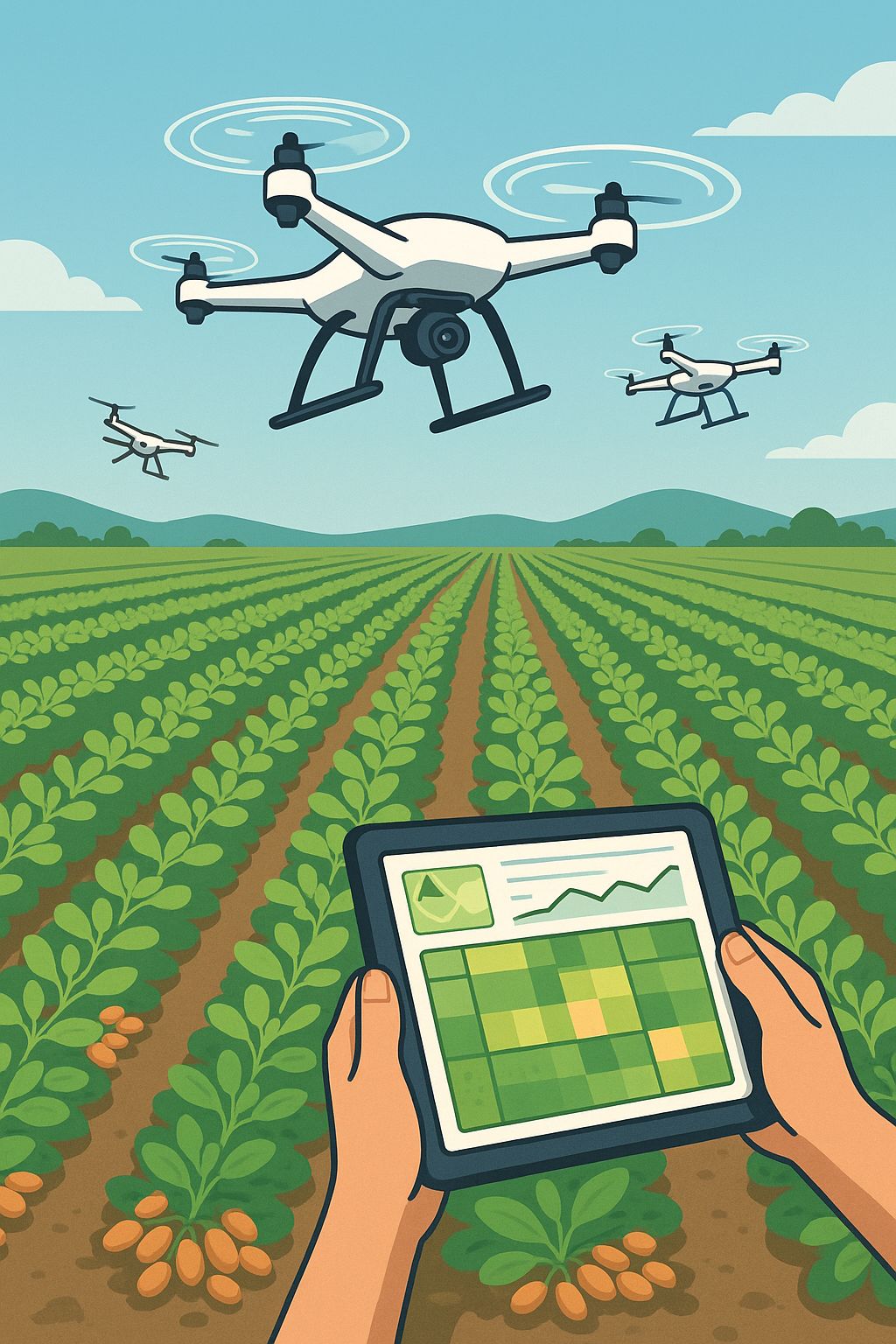Vehículos aéreos no tripulados (VANT) para el monitoreo agronómico de cultivo de maní
DOI:
https://doi.org/10.56124/sapientiae.v8i17.011Palabras clave:
Agricultura de precisión, índices espectrales, vigorosidad de cultivos, análisis espacial, tecnología agrícolaResumen
El presente estudio tuvo como objetivo monitorear las condiciones agronómicas del cultivo de maní (Arachis hypogaea) mediante el uso de vehículos aéreos no tripulados (VANT) equipados con cámara RGB, con el fin de mejorar la eficiencia en el uso de recursos agrícolas. Se evaluaron cinco índices espectrales (GLI, SAVI, RGBVI, MGRVI y VIgreen) en una parcela experimental de 7.000 m2, utilizando un diseño factorial que incluyó cuatro variedades de maní, dos densidades de siembra y dos tipos de labranza. Los datos fueron capturados con un dron DJI Phantom 4 Pro y procesados con software fotogramétrico y herramientas de análisis espacial. Los resultados mostraron que el índice RGBVI presentó los valores más altos de reflectancia (0,52 ± 0,05), siendo el más efectivo para evaluar la vigorosidad del cultivo. Las variedades INIAP-381 e INIAP-383 mostraron mayor vigor, mientras que la labranza convencional favoreció el desarrollo del cultivo en comparación con la labranza cero. La interacción entre la variedad INIAP-381 y la densidad de siembra de 62.500 plantas/hectárea resultó con una mayor reflectancia, indicando un mejor aprovechamiento de los recursos. Estos hallazgos sugieren que el uso de VANT equipados con sensores RGB y el índice espectral RGBVI pueden ser herramientas accesibles y eficaces para el monitoreo de cultivos de maní, reduciendo costos y facilitando la toma de decisiones en la agricultura de precisión. La aplicación de estas tecnologías puede contribuir a la formulación de políticas públicas orientadas a revitalizar el sector manicero en Ecuador, fortaleciendo la cadena de valor incrementando la productividad.
Descargas
Citas
Al-Qubati, A., Zhang, L., & Forkel, M. (2024). Urban and peri-urban agriculture under climate change: A review on carbon emissions and sequestration. Sustainable Cities and Society, 115, 105830. https://doi.org/10.1016/J.SCS.2024.105830
Bello Parra, R. O., Valarezo Beltrón, C. O., & Valarezo Molina, M. J. (2023). Diagnóstico de la cadena de valor de mantequilla de maní en Tosagua, Ecuador. ECA Sinergia, 14(3), 91–104. https://doi.org/10.33936/ECASINERGIA.V14I3.5754
Betiol, O., Bolonhezi, D., Leal, É. R. P., Gruener, C. E., Michelotto, M. D., Furlani, C. E. A., & Ruiz, F. F. (2023). Conservation agriculture practices in a peanut cropping system: Effects on pod yield and soil penetration resistance. Revista Brasileira de Ciencia Do Solo, 47. https://doi.org/10.36783/18069657RBCS20230004
Cedeño Vélez, S. J. (2023). Niveles de fertilización en el cultivo de maní (Arachis hypogaea L.) [Tesis de grado, Universidad Laica Eloy Alfaro de Manabí]. Repositorio de la Uleam. https://repositorio.uleam.edu.ec/handle/123456789/4628
Cuenca, K., Quizhpe C., W. R., & Ramírez-Iglesias, E. (2021). Evaluación de sustentabilidad en sistemas de producción de maíz y maní en la provincia de Loja, Ecuador. Agronomía Tropical, 71: e4567645. https://doi.org/10.5281/ZENODO.4567645
El-Hendawy, S., Al-Suhaibani, N., Salem, A. E. A., Ur Rehman, S., & Schmidhalter, U. (2015). Spectral reflectance indices as a rapid and nondestructive phenotyping tool for estimating different morphophysiological traits of contrasting spring wheat germplasms under arid conditions. Turkish Journal of Agriculture and Forestry, 39(4), 572–587. https://doi.org/10.3906/tar-1406-164
FAO. (2018). Perspectivas por sectores principales. 1–43. https://www.fao.org/3/y3557s/y3557s04.pdf
Fernando, K. M. C., Ehoche, O. G., Atkinson, J. A., & Sparkes, D. L. (2021). Root system architecture and nitrogen uptake efficiency of wheat species. Journal of Agricultural Sciences - Sri Lanka, 16(1), 37–53. https://doi.org/10.4038/jas.v16i1.9182
Ingole, R. S., Ingole, N. S., Khandelwal, R. R., & Kalambe, J. P. (2024). Detection of Crop Disease and Spraying of Pesticides using Drone. 2024 IEEE 9th International Conference for Convergence in Technology, I2CT 2024. https://doi.org/10.1109/I2CT61223.2024.10543617
Jiménez Guayanay, T. A., & Peña Merino, S. B. (2021). Análisis de mercadeo y comercialización en la cadena de valor de maní arachis hypogaea l., en la provincia de Loja[Universidad Nacional deLoja]. https://dspace.unl.edu.ec//handle/123456789/23759
Kamenova, I., Filchev, L., & Ilieva, I. (2017). REVIEW OF SPECTRAL VEGETATION INDICES AND METHODS FOR ESTIMATION OF CROP BIOPHYSICAL VARIABLES. 29.
López Rodríguez, S., van Bussel, L. G. J., & Alkemade, R. (2024). Classification of agricultural land management systems for global modeling of biodiversity and ecosystem services. Agriculture, Ecosystems & Environment, 360, 108795. https://doi.org/10.1016/J.AGEE.2023.108795
Lóránt, B., Veronika, K.-B., & József, B. (2024). Comparison of RGB Indices used for Vegetation Studies based on Structured Similarity Index (SSIM). Journal of Plant Science and Phytopathology, 8(1), 007–012. https://doi.org/10.29328/JOURNAL.JPSP.1001124
Lv, X., Zhang, X., Gao, H., He, T., Lv, Z., & Zhangzhong, L. (2024). When crops meet machine vision: A review and development framework for a low-cost nondestructive online monitoring technology in agricultural production. Agriculture Communications, 2(1), 100029. https://doi.org/10.1016/J.AGRCOM.2024.100029
Marin, D. B., Rossi, G., Araújo, G., Ferraz, S., Dorbu, F., & Hashemi-Beni, L. (2024). Detection of Individual Corn Crop and Canopy Delineation from Unmanned Aerial Vehicle Imagery. Remote Sensing 2024, Vol. 16, Page 2679, 16(14), 2679. https://doi.org/10.3390/RS16142679
Moreira, B. R. de A., Marra, T. M., Silva, E. A. da, Brito Filho, A. L. de, Barbosa Júnior, M. R., Santos, A. F. dos, Silva, R. P. da, & Vellidis, G. (2024). Advancements in peanut mechanization: Implications for sustainable agriculture. Agricultural Systems, 215, 103868. https://doi.org/10.1016/J.AGSY.2024.103868
Pacheco Gil, H. A., & Montilla Pacheco, A. de J. (2020). RGB Spectral Indices for the Analysis of Soil Protection by Vegetation Cover against Erosive Processes. Soil Erosion - Current Challenges and Future Perspectives in a Changing World. https://doi.org/10.5772/INTECHOPEN.95055
Ponce Conforme, A. M., Rodríguez Mala, A. S., & Pacheco Gil, H. A. (2024). Condiciones agronómicas del cultivo de arroz con imágenes de vehículos aéreos no tripulados. Revista Científica Multidisciplinaria SAPIENTIAE. ISSN: 2600-6030, 7(14), 35–54. https://doi.org/10.56124/SAPIENTIAE.V7I14.0003
Qu, H., Zheng, C., Ji, H., Barai, K., & Zhang, Y. J. (2024). A fast and efficient approach to estimate wild blueberry yield using machine learning with drone photography: Flight altitude, sampling method and model effects. Computers and Electronics in Agriculture, 216, 108543. https://doi.org/10.1016/J.COMPAG.2023.108543
Raghuwanshi, S., Chaudhary, R. S., Somasundaram, J., Sinha, N. K., Trivedi, S. K., Kurmi, P., Vijayaraje, R., Krishi, S., Vidyalaya, V., Gwalior, M., & Pradesh, I. (2024). A Comparative Study of Long-Term Conventional and No-Tillage Practices on the Basis of Available Soil Nutrients, Soil Organic Carbon and Crop Productivity in Black Soils of Central India. Asian Journal of Soil Science and Plant Nutrition, 10(3), 561–571. https://doi.org/10.9734/AJSSPN/2024/V10I3369
Shojaeezadeh, S., Elnashar, A., & Weber, T. K. D. (2024). Estimating Crop Phenology from Satellite Data using Machine Learning. EGU24. https://doi.org/10.5194/EGUSPHERE-EGU24-15347
Sumesh, K. C., Ninsawat, S., & Som-ard, J. (2021). Integration of RGB-based vegetation index, crop surface model and object-based image analysis approach for sugarcane yield estimation using unmanned aerial vehicle. Computers and Electronics in Agriculture, 180, 105903. https://doi.org/10.1016/J.COMPAG.2020.105903
Swethasree, M., Sudhakar, P., Umamahesh, V., Prathima, T., & Krishna, T. G. (2024). Effect of planting density on yield and architecture suitability of groundnut (Arachis hypogaea) varieties. Indian Journal of Agricultural Sciences, 94(3), 297–302. https://doi.org/10.56093/IJAS.V94.I3.138914
Wajhat, N., V, N., SA, N., & ZA, D. (2019). Drought tolerance mechanism in wheat: A Review. The Pharma Innovation, 714–724. https://doi.org/https://dx.doi.org/10.22271/tpi
Zhang, P., Lu, B., Ge, J., Wang, X., Yang, Y., Shang, J., La, Z., Zang, H., & Zeng, Z. (2025). Using UAV-based multispectral and RGB imagery to monitor above-ground biomass of oat-based diversified cropping. European Journal of Agronomy, 162, 127422. https://doi.org/10.1016/J.EJA.2024.127422

Publicado
Cómo citar
Número
Sección
Licencia
Derechos de autor 2025 Revista Científica Multidisciplinaria SAPIENTIAE. ISSN: 2600-6030

Esta obra está bajo una licencia internacional Creative Commons Atribución-NoComercial-CompartirIgual 4.0.

2.jpg)

















